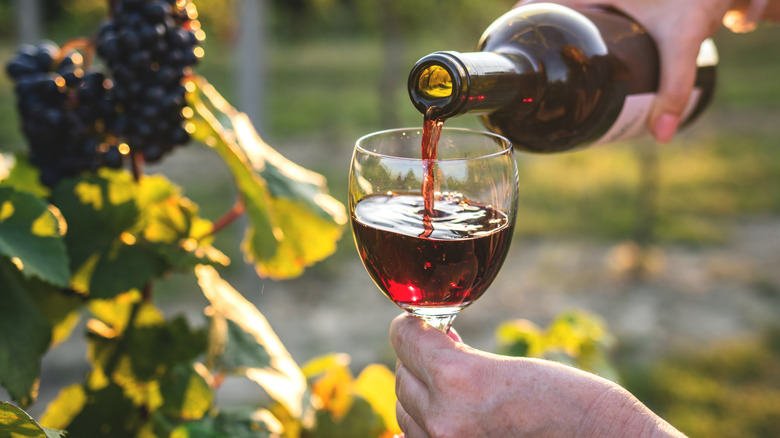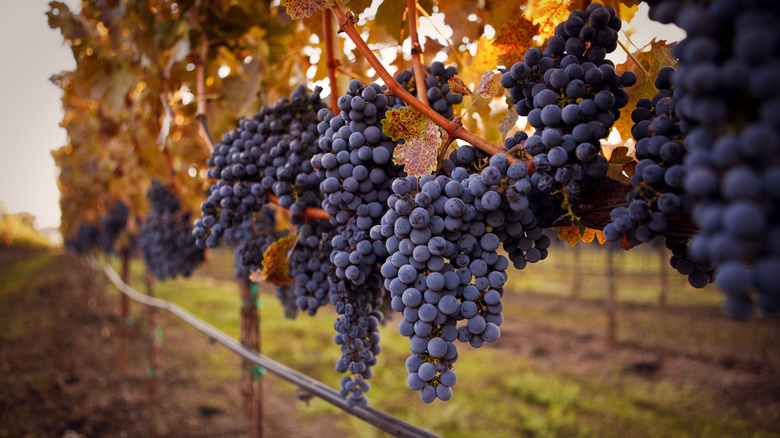The Reason Cabernet Sauvignon Wine Is So Popular
Cabernet Sauvignon is among the most planted grape varieties in the wine world. Due to the well-established prominence of this French grape, one might assume it belongs to the ancient varieties, like its more expensive compatriot Pinot Noir, the Italian Bellone and Nero Buono, or Georgian Saperavi. However, Cabernet Sauvignon, a variety created from crossbreeding Cabernet Franc and Sauvignon Blanc, can only be traced back to the 18th century in Bordeaux, making it a relatively young grape.
How did it become so well-known and beloved in such a short time? In short, by being an absolute powerhouse. Delicious, dynamic, and versatile when young, Cabernet Sauvignon also ages incredibly well due to its high acidity levels, making it a great choice for cellaring. This grape thrives in wine regions around the world, each imparting a unique terroir, and highlighting different facets of its personality. It produces exceptional wine at every price point, both as a single varietal and in blends, and pairs well with a wide variety of dishes. No matter your preference in red wine, there's likely a bottle of Cabernet Sauvignon that will meet your expectations.
Why Cabernet Sauvignon is so widely grown
Approximately 18 million acres of land are dedicated to growing grapes for wine, with over 713,000 of those acres cultivating Cabernet Sauvignon. Bordeaux, France, and California's Napa Valley are most renowned for their Cabernets; however, Chile, Australia, Spain, and many other countries also produce exceptional harvests. From a cultivation standpoint, the grape is highly regarded for its hardy vines, thick skin, and large yields. Unlike more delicate grapes, which are vulnerable to sunburn, temperature fluctuations, and pests due to their thin skin, Cabernet Sauvignon grapes are more resilient, and consistently reach harvest.
The grape's ability to thrive in a diverse range of wine regions, each bringing out unique flavor profiles in the grape, further contributes to its popularity. While certain characteristics are consistent across this wine variety — such as being dry and full-bodied, with relatively high tannins and acidity — the tasting notes of a California Cabernet differ from those of a French one.
In its native Bordeaux, savory flavors like anise, tobacco, pencil lead, and woody notes from French oak aging complement the fruity tastes of currant, cherry, and plum. In Napa Valley's warmer climate, there's a similar complexity and structure, but with more pronounced fruit ripeness, generally higher alcohol content — here's why some wine is more alcoholic than others — and an earthy quality typical of the region's volcanic soil. This variance makes Cabernet Sauvignon an intriguing wine to explore.
How to enjoy this wine
With its wide range of flavors, Cabernet Sauvignon is an effortlessly enjoyable wine. Enjoyed on its own, it allows you to leisurely appreciate the flavors, textures, and aromas that define the wine in your glass. Additionally, it serves as an excellent wine for pairing with food, offering the chance to explore how each element enhances and influences your meal.
Possessing medium-high tannins and a full body, Cabernet Sauvignon pairs wonderfully with rich, bold meals such as grilled steak, duck, or lamb, comforting risotto, creamy cheese plates, and other decadent flavors. Don't fall for the wine myth that red varieties can't accompany seafood, either. Despite common misconceptions, Cabernet Sauvignon can be delightful when paired with salmon or another grilled fish steak — particularly if the fish is prepared with a spice-rich marinade or served with a smoky, peppery sauce. Regardless of the specific dishes on the menu, if they boast intense flavors, selecting a Cabernet Sauvignon that can match their vigor is sure to enhance the dining experience.



